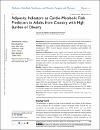Adiposity indicators as cardiometabolic risk predictors in adults from country with high burden of obesity
| Author | Kerkadi, Abdelhamid |
| Author | Suleman, Dana |
| Author | Abu Salah, Lana |
| Author | Lotfy, Christina |
| Author | Attieh, Grace |
| Author | Bawadi, Hiba |
| Author | Zumin, Shi |
| Available date | 2020-02-04T05:35:18Z |
| Publication Date | 2020-01-20 |
| Publication Name | Diabetes, Metabolic Syndrome and Obesity: Targets and Therapy |
| Identifier | http://dx.doi.org/10.2147/DMSO.S238748 |
| Citation | Kerkadi, Abdel & Suleman, Dana & Salah, Lana & Lotfy, Christina & Attieh, Grace & Bawadi, Hiba & Shi, Zumin. (2020). Adiposity Indicators as Cardio-Metabolic Risk Predictors in Adults from Country with High Burden of Obesity. Diabetes, Metabolic Syndrome and Obesity: Targets and Therapy. Volume 13. 175-183. 10.2147/DMSO.S238748. |
| ISSN | 1178-7007 |
| Abstract | Background : In Qatar more than 70% 0f the adults are overweight and obese. Different adiposity assessment methods have been proposed to identify individuals at cardio-metabolic risk. Purpose : This study aimed to compare anthropometric indicators with Dual-energy X-ray absorptiometry (DXA) –derived adiposity indicators in predicting cardio-metabolic risk among Qatari adults. Patients and methods: A random sample of five hundred and fifty-eight (558) healthy Qatari adults (men and women) aged 20 to 50 years was obtained from Qatar Biobank survey data. Anthropometric data (weight, height, and waist circumference), the DXA-derived data, and cardio-metabolic (CM) risk parameters were analyzed. A Spearman partial correlation coefficient , Receiver Operating Characteristics (ROC) curve and an area under curve (AUC) were used to assess the predicting ability of adiposity indicators for CM risk factors. Results: Adiposity indices (anthropometric and DXA) were significantly correlated with most of the CM indicators (r= -0.292 to 0.486, p< 0.001). The AUC of waist to height ratio (WHtR) was significantly higher than that of body mass index (BMI) and waist circumference (WC) in the prediction of low high density lipoprotein (HDL) (AUC=0.65, AUC=0.59; AUC=0.64), high low density lipoprotein (LDL) (AUC=0.67; AUC=0.62; AUC=0.66), high cholesterol (AUC=0.66; AUC=0.63; AUC=0.63), and high Homeostatic Model Assessment- (HOMA) (AUC= 0.81; AUC= 0.78; AUC=0.78). Among DXA- parameters, trunk fat had the highest AUCs for total cholesterol (AUC= 0.64, CI=0.56, 0.73), triglycerides and glucose index (TyG) (AUC=0.69, CI=0.64, 0.74), and HOMA (AUC=0.78, CI= 0.73, 0.84). Conclusion: Results of the present study show that adiposity indicators (WC and WHtR) are clinically valuable tools to identify individuals at risk of CVD compared to DXA–derived parameters, while DXA can provide more accurate estimates. |
| Sponsor | The project was funded by Qatar University, grant number QU-2-CHS-2018-3. Article processing charges fees were handled by Qatar National Library. |
| Language | en |
| Publisher | Dove Medical Press |
| Subject | Qatar Biobank adiposity indices cardiometabolic indicators Dual-energy x-ray absorptiometry |
| Type | Article |
| Pagination | 175-183 |
| Volume Number | 13 |
Files in this item
This item appears in the following Collection(s)
-
Human Nutrition [404 items ]


